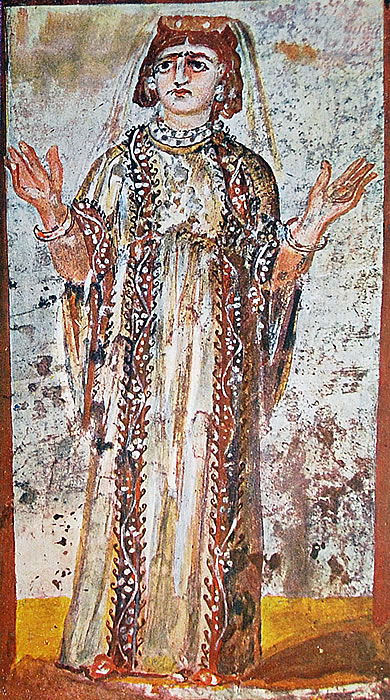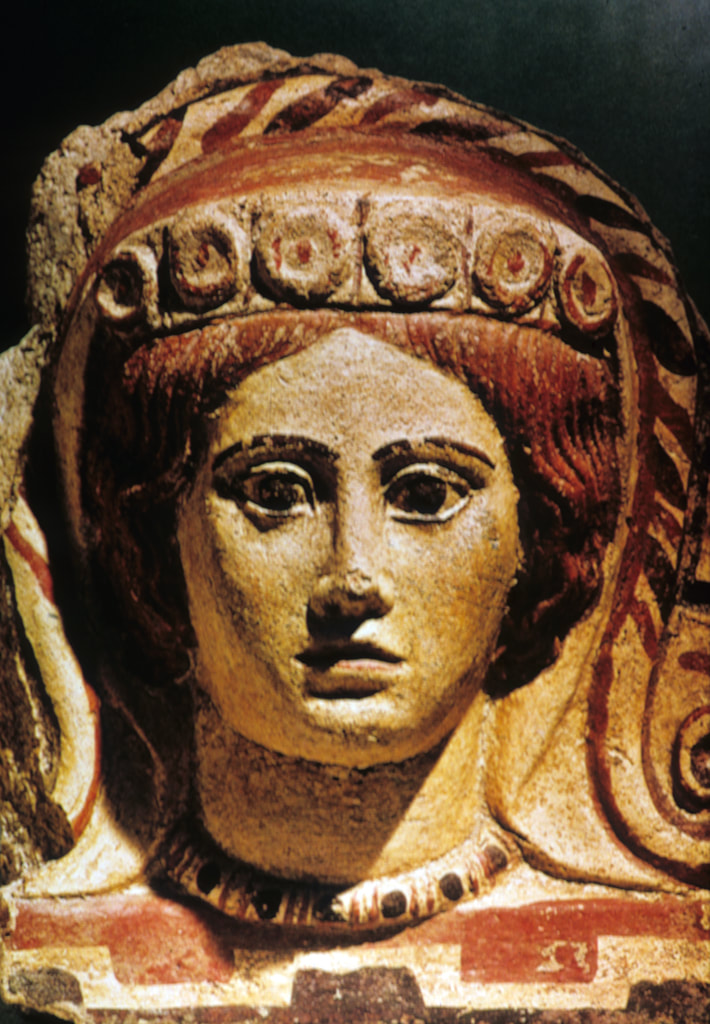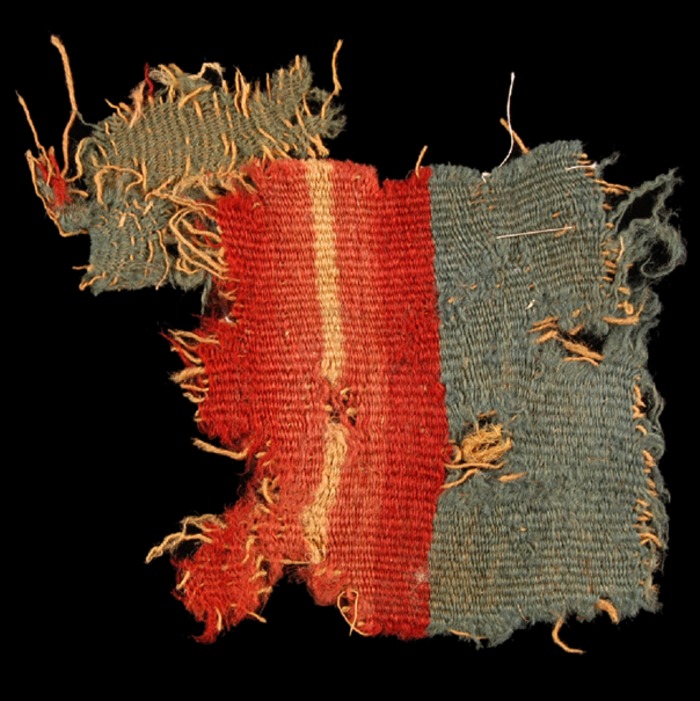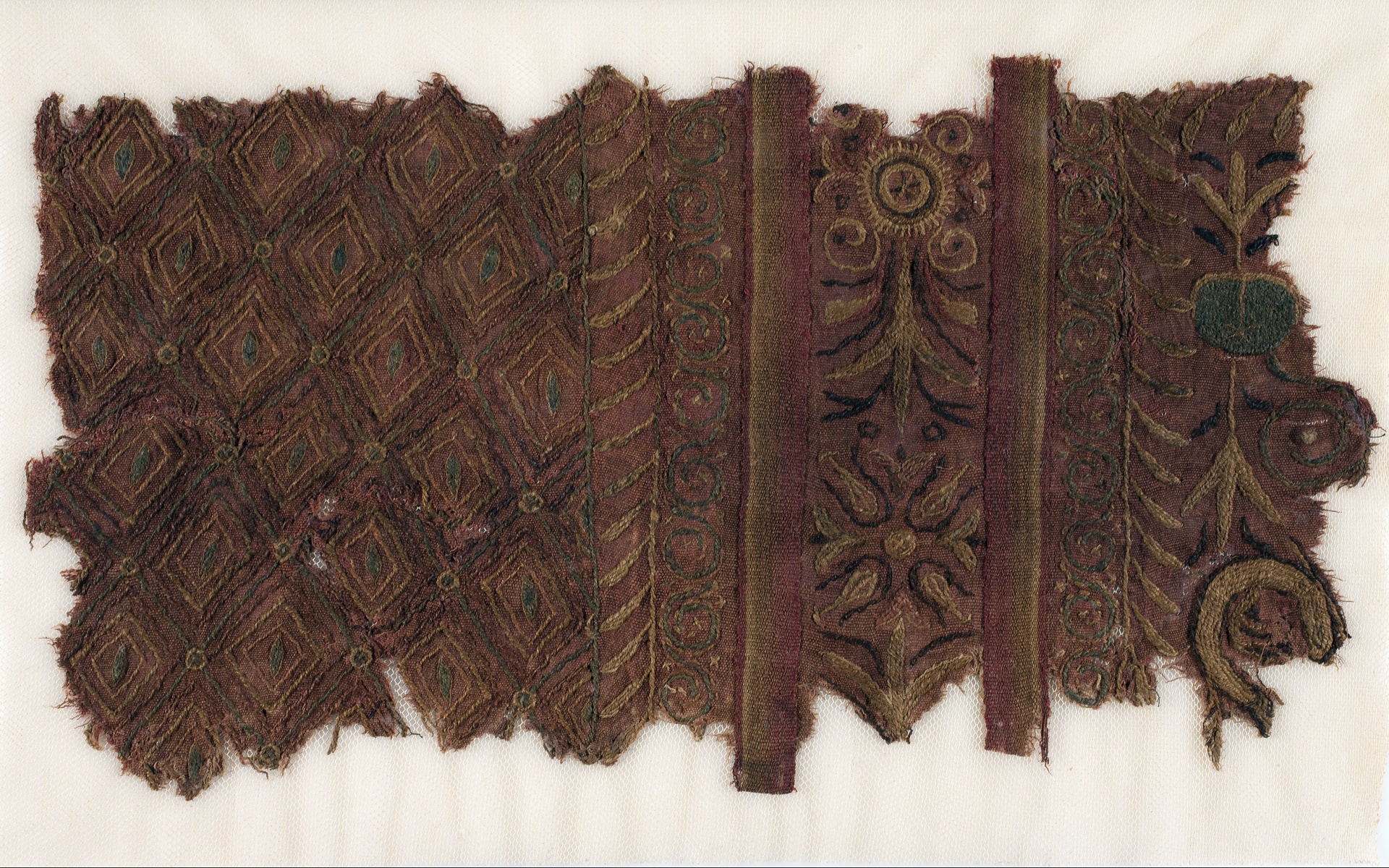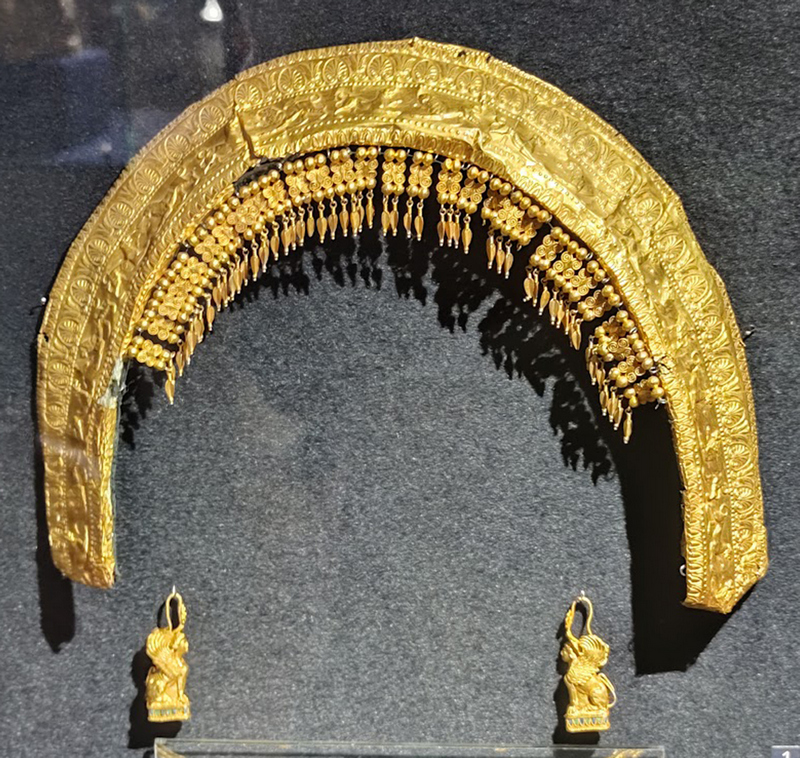 Painted details of Kore Acr. 685 (Schrader I, pl. III) |  Painted details of the Peplos Kore (Peplophoros) (Acr. 679) and of Kore Acr. 594 (Schrader I, plates I and V) Acropolis Museum catalog |

“Examples of colourations solely depicting visible traces of paint. The two watercolours render preserved polychromy on the so-called Peplos Kore and Chios Kore (Athens, Acropolis Museum, inv. no. 679 and 675), respectively. They were painted by Émile Gilliéron in 1909. Gilliéron produced many similar illustrations for scholarly publi-cations in the late 19th and early 20th centuries.”
Lost in Translation: An Introduction to the Challenging Task of Communicating Long-lost Polychromy on Graeco-Roman Marble Sculptures Cecilie Brøns, Signe Buccarella Hedegaard, 2019

Kore 685 © Nikos Pilos
“Kore 685: the original statue and a modern, painted replica, reproduced with a high degree of accuracy thanks to the efforts of the Swiss painter Émile Gilliéron a century ago. The coloring is based on archival watercolors, completed immediately after the statue’s discovery in 1888.”

Chios Kore (Acr. 675), by Émile Gilliéron 
Watercolor by Emile Gilliéron 
Sketches by Wilhelm Lehrmann
Picture 1: The decorative details of the Chios Kore (Acr. 675), as recorded by Émile Gilliéron during the excavation of the statues on the Acropolis.
Picture 2: Watercolor by Emile Gilliéron, Kore Acr. 685.
Picture 3: Sketches of the color schemes on the Kore as documented by Wilhelm Lehrmann
The Chiotissa (Chios Kore), a small kore associated with the art of Chios (Acr. 675)

Chios Kore, Acr. 675 © Nikos Pilos 
Chios Kore, Acr. 675, Acropolis Museum catalog

The watercolor reproduction of The Introduction of Herakles into Olympos by Emile Gilliéron père, a pediment of a temple from Acropolis.

Antenor Kore, Acr. 681 © Nikos Pilos 
Antenor Kore, Acr. 681 © Nikos Pilos 
Antenor Kore, Acr. 681 Acropolis Museum catalog 
Antenor Kore, Acr. 681 Acropolis Museum catalog
The Antenor Kore, Acr. 681 (525-500 BC) is the largest kore from the Acropolis, a work of the sculptor Antenor. Prominent are vertical bands, alternating red and blue, which adorn the sleeves of her robe.
| Tall Kore (Acr. 682), Acropolis Museum catalog | |
|---|---|
 |  |

Tall Kore, Acr. 682; photo Tilemahos Efthimiadis 
Tall Kore, Acr. 682 detail after Olga Palagia
“Primary colors commonly used on sculptures of the Archaic period included red in various shades, dark blue or light blue, black, yellow and green. The paint was applied in layers of various thicknesses. Among these colors, red was predominant, perhaps due to its easy accessibility and the symbolic value given to it by Mediterranean people. Blue or black was associated with marine life and Poseidon. On Archaic kore (maiden) sculptures from the Acropolis, green and brown have been detected in association with features of the face and head such as eyes and hair.
For the skin of kore figures, ancient painters used light-brown/yellow (ochre). The traces of color found in their eyes show they had a piercing gaze. The iris was decorated with two superimposed layers of red and brown paint that gave depth to their gaze and expressiveness to their faces. The pupil was black/dark. The eyelids were accentuated with black or dark brown border lines. On the hair of most kore figures, traces of brilliant red color are preserved, while occasionally a second, deep- brown layer is also evident, as in the Chios Kore. Light blonde or blue colors have also been observed.
The robes of kore sculptures are believed to represent actual clothing decorated with patterns, familiar to us from the painted decoration of vases. This was luxurious attire, indicative not only of female vanity, but especially of their social status and perhaps their votive character. The chiton, himation and peplos were adorned with bands of meanders, continuous spirals, palmettes, coiling tendrils, lotus blossoms and even pictorial scenes. Various accessories and types of head ornaments and jewelry – earrings, necklaces, bracelets and pins – as well as buttons and belts complete the kores’ ornamentation.” (Recreating the True Painted Colors)
 Kore in Ionian dress (Acr. 594) Acropolis Museum catalog |  Kore in Ionian dress (Acr. 594), detail |
 Kore holding a quince in her extended right hand (Acr. 680), Acropolis Museum catalog Kore holding a quince in her extended right hand (Acr. 680), Acropolis Museum catalog |
SOURCES:
- Acropolis Museum catalog
LATSIS GROUP
ATHENS 1998
© The Hellenic Ministry of Culture - Article: Acropolis Museum: “Recreating the True Painted Colors of Ancient Statues” 2017, by Natasha Blatsiou;
photos © Nikos Pilos website >> - Acropolis Museum, Kore from Chios, Acr. 675 https://www.theacropolismuseum.gr/en/statue-kore-kore-chios
- The watercolor “The Introduction of Herakles into Olympos” The Metropolitan Museum
See also: Watercolors of the Acropolis: Émile Gilliéron in Athens: The Metropolitan Museum of Art Bulletin, v.76, no. 4 (Spring, 2019) Met publication - Watercolor by Emile Gilliéron, Kore from Chios, Acr. 675 reddit >>
- Kore in Ionian dress (Acr. 594), detail of a chiton
- Lost in Translation: An Introduction to the Challenging Task of Communicating Long-lost Polychromy on Graeco-Roman Marble Sculptures Cecilie Brøns, Signe Buccarella Hedegaard, 2019
- Tall Kore, Acr. 682 photo Tilemahos Efthimiadis
- Tall Kore, Acr. 682 detail, Olga Palagia Sculpture grecque antique: developpements recents et themes dominants academia.edu

